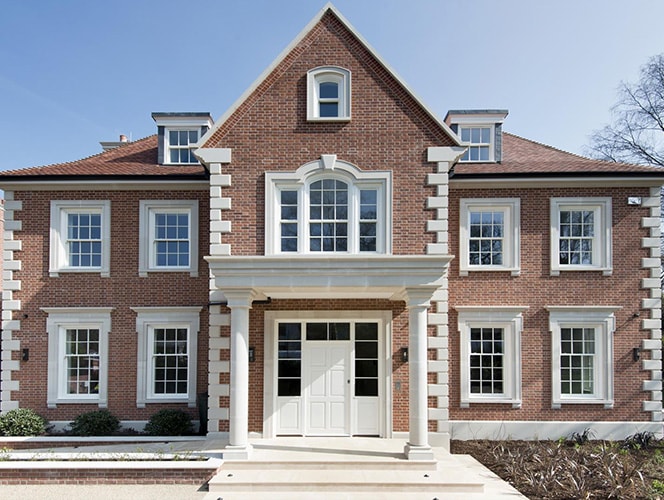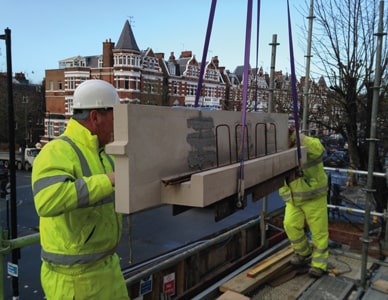Understanding Cast Stone
A Guide to Cast Stone Products for Specifiers 3rd edition – August 2016
Introduction
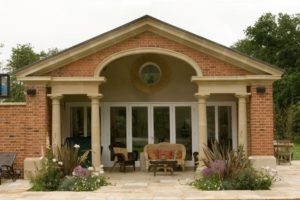
Cast stone achieves the following…
- Adds perceived value to housing developments
- Incorporates styling features within prestigious projects
- Mimics traditional details in infill developments or alterations to period properties
- Cost-effectively creates bespoke internal features such as fireplace surrounds
- Substantially reduces costs where repetitive work is required
Design Considerations
Aesthetics
Almost any three-dimensional geometric form can be cast, enabling architects to design elegant curves as well as straight-edged features. Additional detail can also be incorporated into the surface, such as brick-effects or channels, and the edges of units can be square, bevelled or radiused. Cast stone units can be used to complement brickwork, quarried stone, flint or rendering.
Standard colours are available to match those of quarried stone, such as Bathstone, Red Sandstone or Portland stone, while non-standard colours can also be produced to meet a client’s specific requirements. Procter Cast Stone offers a PDF datasheet with photographs of samples in standard colours, or colour sample packs are available on request. Unlike quarried stone, the colour of cast stone is very consistent, both within a batch and from one batch to the next. If required, however, controlled variation can be introduced to mimic the effect found in quarried stone. Over time, cast stone weathers the same way as quarried stone.
Note that cast stone has been used successfully on listed buildings in conservation areas. If there is resistance to the use of cast stone in such projects, Procter Cast Stone can assist architects and developers in discussing the issue with planners.
Surface finish
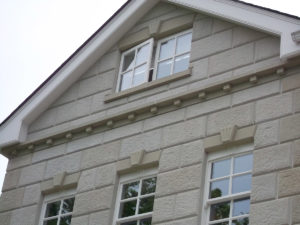
Slenderness ratio
To provide sufficient inherent strength during manufacture and handling, there is a limit to the slenderness ratio for a cast stone product. The slenderness ratio (S) is defined as the ratio of the length (L) to the diameter (d), where the diameter refers to an inscribed or superscribed circle on the section of the product, determined by the support plane (ie S=L/d). Unless otherwise agreed between the specifier and manufacturer, S should be less than or equal to 12, though alternative ratios can be used by agreement with the manufacturer.
Large openings
Where large openings are required, due consideration should be given to incorporating bed joint reinforcement above and below. It is recommended that the maximum distance between vertical movement joints should be 6m. To reduce the risk of cracking in stooled cills only, the ends should be bedded in mortar; the joint below should be left open and, upon completion of the brickwork, the joint should be pointed.
Mechanical and structural strengthWhere possible, all units are cast in a two-stage process. A facing mix provides the stone appearance on the exposed faces and a backing mix adds strength and forms a good bond with the facing mix and reinforcement, where used.
Products intended for use in compression, such as quoins, string courses and walling units, can be readily used as structural units.
Where a steel lintel is used, the lintel would normally be positioned beneath the head to support the entire lintel and brickwork load. However, if the lintel is to be installed over a self-supporting cast stone head such that the lintel supports the brickwork load only, the manufacturer of the cast stone should be consulted first.
Three cube samples shall be tested to ensure that the material meets the requirements specified in BS EN 12390-3:2009 (Testing hardened concrete. Compressive strength of test specimens). Following a recent investment in new computer-controlled batching equipment and a climate-controlled curing chamber, Procter’s cast stone products are now even stronger.
Differential movement
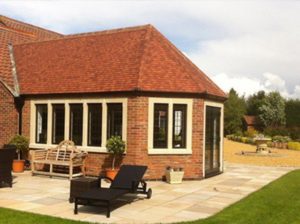
Damp proofing
To prevent the ingress of rainwater and damp, attention should be paid to the design and detailing of damp proof membranes and/or cavity trays. Good site practice is also essential.
For cills, a horizontal damp proof membrane should be provided for the full length and width of the cill bed. This membrane should be turned upward to cover the vertical inner face of the cill and extend as far as the cavity tray or window board.
Beneath copings to freestanding walls, parapet walls and similar structures, it is good building practice to provide a continuous damp proof membrane sandwiched in mortar and projecting beyond each face of the wall by at least 5mm.
Design for long-term maintenance of good appearance
To avoid staining, projections should incorporate a drip groove. Cills and heads should also be provided with drip grooves in the soffit.
Care should be taken to avoid the possibility of water running onto cast stone from lead or copper flashing. Alternatively, non-metallic flashing may be used, but the manufacturer of the cast stone should be consulted prior to specifying the flashing.
Good building practice
It is essential to use good building practice when designing all building materials – including cast stone. General guidance can be sought from manufacturers, and relevant standards should be consulted.
Design-for-manufacture
Cast stone, which is sometimes known as reconstituted stone, simulated stone or Artstone, is normally produced in a mould that is open on one side; the product is turned out onto this side for finishing. It is therefore advisable to design cast stone products such that there is one major flat unexposed surface, otherwise the cost will rise to take account of the additional manufacturing difficulty.
Because of the way cast stone is moulded, certain design details can be easier or more difficult to produce in bespoke components — and the difference is reflected in the price. The manufacturer should therefore be consulted at the design stage in order to avoid unnecessary costs being incurred.
Larger components are normally produced with integral threaded sockets to enable lifting hooks to be inserted for moving and positioning the units on site. The manufacturer will locate the threaded sockets to suit the functional requirements and the production process, while taking care to avoid faces that will be visible once construction is complete. It is therefore important that unit drawings clearly show which faces will and will not be visible.
CAD file exchange
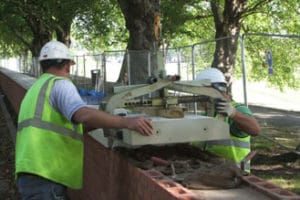
Site practice
Delivery
To ensure that every cast stone unit arrives on site in the best condition possible, Procter Cast Stone only uses its own transport. Deliveries are made to agreed schedules to ensure that the products do not spend any longer than necessary on site, which helps to minimise the risk of damage. If the project is delayed for any reason, deliveries can be rescheduled accordingly.
Palletised deliveries of cast stone products should be unloaded using a grab or forklift with suitable forks. Slings, scaffold poles and similar arrangements should not be used.
Palletised loads are best left in their protective packaging until required, but individual items should be visually inspected upon delivery. Any damage should be described on the delivery note and reported to the manufacturer by telephone, fax or email.
Storage
As with all other building materials, cast stone units must be stored with care to avoid damage such as staining, chipping and cracking — particularly items with fine detail or sharp arrises. Slender units should be handled and stored in the plain in which they are to be installed unless the manufacturer provides alternative instructions.
Cast stone products should preferably be stored well away from areas of heavy traffic. Palletised products should be stored on flat, level, dry ground, and pallets should never be stacked. Individual items should also be stored on flat, level, dry ground, supported by suitable bearers placed one-quarter to one-third of the way in from each end to provide adequate support while preventing point loading.
On-site handling
As with quarried stone, careful handling of cast stone is essential in order to avoid damage. If additional handling instructions are required, these can be provided by the manufacturer.
Exterior strapping and packaging should be cut away with a sharp knife, taking care to avoid scoring the surface of the cast stone. Once the packaging has been opened, the cast stone should be loosely covered with polythene to prevent contamination while maintaining an adequate airflow to avoid the formation of condensation.
Interior packing should be reused to protect faces and arrises during site handling. Additional packaging materials can be provided upon request.
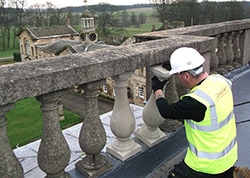
If any machinery is to be used to handle the cast stone units, contact the manufacturer to discuss the best types of grabs to use. Threaded sockets are often incorporated within cast stone units to facilitate movement using threaded eyes and appropriate lifting equipment.
Shock loading can cause damage to cast stone and should therefore be avoided at all times — such as when pallets are being moved. Units should be adequately supported to ease handling and eliminate the need to ‘drop’ the product if being handled manually.
Individual units should not be slid across any supporting surface or across each other.
Installation
Cast stone should only be installed by suitably experienced operatives who have been made aware of the guidelines below.
When units are removed from storage they should be protected until they have been installed.
On all but the simplest of projects, cast stone units can be labelled so that they can be individually identified, enabling their positions to be determined unambiguously from unit location plans issued by the manufacturer.
All units should be laid and adjusted to their final position while the mortar is still plastic. Mortar exuded from joints should be cut away, taking care not to smear the face of the cast stone. During cold weather, fresh mortar should be protected from frost damage.
Cast stone products are generally designed to be fixed with 6mm joints between units. Locating holes for dowel joints should be completely filled with an appropriate material such as a proprietary resin mortar.
Constructions should be braced to avoid freshly assembled materials being damaged.
At the end of each day it is recommended that the top of that day’s work should be protected to prevent contamination and the ingress of water. Nevertheless, airflow around the cast stone units should not be restricted, and on no account should anything be stuck directly to the unit faces.
It is recommended that finished work be protected with appropriate gauge polythene sheeting to avoid mortar drips, mastic, paint and other construction materials from staining or adhering to the cast stone. Mortar, in particular, is difficult to remove.
Unprotected items such as scaffold poles and planks should not be supported directly on cast stone.
Fixings
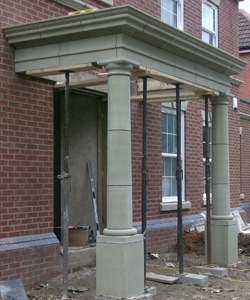
Mortars
It is essential to use the correct grade of mortar when installing cast stone, as incorrect mortars can result in cracks appearing in long units due to differential movement. While these cracks are seldom of any structural significance, they detract from the visual appearance.
Note that the mortar is frequently different from that used in surrounding brickwork; plain sand and cement mortars are not recommended. However, mortars containing lime are strongly recommended, as they are, to a certain extent, self-healing.
Exposed joints may benefit from the water-repellence imparted by proprietary water-proofers added to mortars. The following table gives recommended mortars for different exposure conditions:
|
Exposure conditions severe
moderate |
masonry cement: sand 1 : 4.5
1 : 6
|
plasticised cement: sand 1 : 6
1 : 8 |
cement : lime : sand 1 : 1 : 6
1 : 2 : 9 |
Installation service
Individual cast stone products can be installed by suitably experienced operatives but, for more complex cast stone structures such as porticos, steps and balustrade, Procter Cast Stone offers an installation service. This comprehensive service is available throughout the UK and overseas for both standard and bespoke products. By using the installation service, clients can be certain that the cast stone will be correctly installed, pointed and cleaned. Furthermore, the work will be carried out as quickly as possible and with minimal risk because the cast stone remains Procter’s responsibility until installation is complete. All of Procter’s installers are employed directly, rather than being sub-contractors, to maintain the highest possible quality.
Aftercare and maintenance
Efflorescence
Efflorescence is a temporary, naturally-occurring phenomenon that manifests as a white deposit on all or part of the surface. It occurs to varying extents on all items containing cementitious binders, and mortar is particularly susceptible to efflorescence. While it can affect other materials, such as brick or cast stone, it is not detrimental to the materials’ structural integrity.
Generally it is recommended that the phenomenon be allowed to disappear naturally but, should chemical treatment be deemed necessary, the manufacturer of the cast stone should be consulted prior to any chemicals being applied to its products.
The risk of efflorescence occurring is reduced by protection on site before and during installation.
Maintenance and Cleaning

Under most conditions, cast stone will weather in a similar way to quarried stone and will require no maintenance for many years. However, it may be desirable to clean cast stone, in which case the main methods that can be used are: water washing, mechanical cleaning, air abrasives, the proprietary JOS method, chemical cleaning, alkaline cleaning, acid cleaning, and soaps and poultices. Most techniques have both advantages and disadvantages, so it is recommended that the manufacturer be consulted prior to the selection of any cleaning treatment.
Repairs
Small repairs can often be carried out on site by the manufacturer, with the colour of the repair soon weathering to match that of the surrounding material. During installation, if a unit is damaged beyond repair then a complete replacement unit can usually be manufactured and delivered to site within two weeks, provided the mould is available.
Check cast stone standards online
CE marking
The EU Construction Products Regulation 305/2011 (CPR) came into force in July 2013, replacing the Construction Products Directive (CPD). Initially there was confusion and conflicting advice over which standards should be applied, and whether cast stone products should be CE marked to the CPR. However, following an extensive UK-wide consultation led by UKCSA and involving BSI, there is now industry consensus on the circumstances under which cast stone products should be CE marked. Guidance documents are now available but, in simple terms, the advice is that there is no need to CE mark cast stone products unless they are standard ashlar walling blocks manufactured to BS EN 771-5, regardless of whether they are being manufactured for stock or to fulfil a specific order.
Supplier selection
It is vital to select the right supplier of cast stone products to ensure that the units are correctly manufactured to the agreed specification and will perform as required. Procter Cast Stone provides free technical consultations to assist architects and specifiers in selecting and designing cast stone features. Site meetings can be arranged, and specialists can attend meetings with developers, architects and planners in the early stages of a project. Further advice is available regarding handling, installation and cleaning.
Fully detailed quotations are prepared against architects’ drawings or bills of materials in a timely fashion to suit customers’ tender dates. Alternatively, budget prices can be provided on request.
For every project Procter Cast Stone appoints a contract manager who acts as the single point of contact for the customer and ensures that all aspects of the project are performed to the highest possible standards. Procter Cast Stone is renowned for its exceptional customer service and is a Full Member of the UK Cast Stone Association (UKCSA).

